Table of contents
Amanda Enterprise supports backup and recovery of NDMP appliances using NDMPv4 (version 4) protocol. It does not support earlier versions of NDMP protocol. Amanda Enterprise supports Remote NDMP, Direct NDMP as well as 3-way NDMP configurations.
In Remote NDMP configurations, NDMP appliance such as Netapp Filers, Sun Unified Storage and BlueArc storage are backed up to tape changers and disk attached to the Amanda server. The backup and recovery data goes through the server. In Direct NDMP and 3-way NDMP configurations, Appliances can be backed up to a tape changer that is attached to a SAN or using iSCSI and is accessible from the appliance. The backup and recovery data is not transferred through the server. The Amanda backup server acts as a backup control program.
NDMP backup and recovery in Amanda Enterprise is implemented as an Amanda application. As a result, management of NDMP backup and recovery is identical to other applications. The Amanda disk list entries (DLEs) for NDMP can be present in a backup set that has other application DLEs. This configuration is not recommended.
The NDMP backups from an appliance can be restored to an appliance from the same vendor.
Requirements for NDMP Backup and Restore
- Amanda server must be running Linux or Solaris distribution listed on the Zmanda Network Supported Platforms page.
- Amanda Enterprise server (including dependencies) must be installed on the Amanda server.
- The Amanda server includes the NDMP application. The NDMP backup can be performed only from the Amanda server not from Amanda client.
- NDMP services must be enabled on the appliance. For example: the following figure shows how to check if NDMP services are enabled on BlueArc Storage.
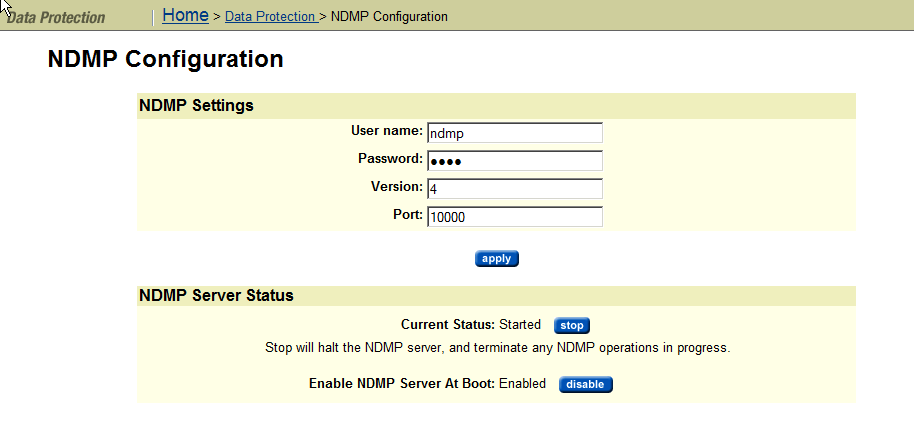
Installation
- No additional packages are required for NDMP application. Amanda server includes all necessary software.
- Zmanda's NDMP application module is a licensed application. All product licences from Zmanda are in a single license file. If you have bought licenses recently, you will have to download the license file from Zmanda Network. The license file should be installed as /etc/zmanda/zmanda_license on the Amanda server. It should be owned by amandabackup user and disk group with file permissions 755.
Configuring NDMP volumes/directories for Backup
Configuring NDMP backups requires configurations steps using Zmanda Management Console and some manual steps.
- Zmanda recommends creation of separate backup set for NDMP backup.
- Create a backup set for the NDMP appliance in the Zmanda Management Console.
- Add the new NDMP entries to the backup set using the Backup What page. Begin by selecting NDMP from the File System drop down menu. The following figure shows an example backup configuration of /vol/zmanda_fs1 from Netapp Filer with IP address 192.168.29.151:
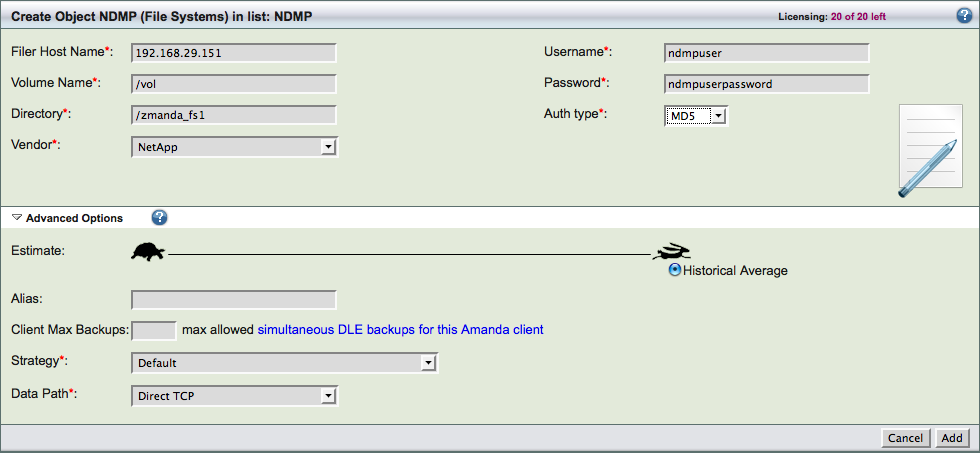
Filer Host Name is the IP address or host name of the NDMP appliance.
Volume Name is the name of NDMP volume.
Directory is the directory in the NDMP volume that is being backed up.
Vendor is the NDMP appliance type. It can be Netapp, BlueArc or Sun Unified Storage.
The Username and Password are the user credentials for performing backup and recovery from the NDMP appliance. The user should have privileges to perform NDMP backup and recovery.
Auth type can be MD5 or Text. This is the type of authentication used to connect to the NDMP appliance from the Amanda server.
Data Path can be DirectTCP or Amanda. The DirectTCP provides LAN free backups i.e, backups are sent directly from the appliance to the tape changer. The Amanda data path allows the user backup to NDMP appliances to the media accessible from the Amanda server. For DirectTCP data path, the staging area is automatically disabled.
You can use only Amanda or DirectTCP data path in an Amanda server. The Amanda data path requires a patch that can be downloaded from the Zmanda Network downloads page.
Compression and Encryption cannot be used for DirectTCP data path. Compression and Encryption can be performed for Amanda data path.
Click Add to save the configuration to the backup set. ZMC performs automatic verification of the configuration when the configuration is saved.
- If you are configuring Backup devices that are connected to the Amanda server for this backup set, use the Admin Devices and Backup Where pages to configure the devices. This should be done in Remote NDMP configurations. For Direct NDMP and 3 way NDMP configurations, please configure NDMP Changer. This procedure is described in the next section.
Configuring NDMP tape changer
This procedure has to be performed for Direct NDMP and 3-way NDMP configurations. It is not required for Remote NDMP configurations. For remote NDMP configurations, you can use Disk or Tape Changer or Amazon S3 from the ZMC Admin Devices page.
- Create a NDMP changer device in ZMC Admin Devices page.
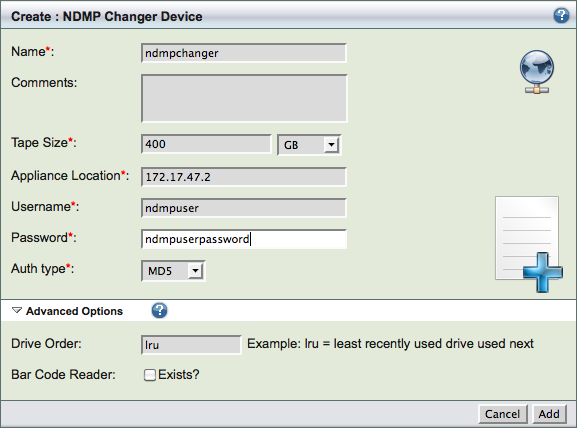
Name and Comments can be specified to identify the NDMP changer device.
The Tape Size must match the size of tape used in the tape changer.
The Appliance location should be the IP address of the NDMP appliance that can access the tape changer followed by changer name in the format XX.XX.XX.XX@changer-name For example: 172.17.47.2@mc0
The changer name can be found using Netapp filer storage show mc command. Make sure the tape changer can be seen by the filer or appliance (check to see SAN zoning has been done correctly).
In case of BlueArc NDMP storage, you can find changer name and drive name in the user interface as shown in the figure below.

In case of Sun Unified Storage, use BUI to the NDMP tape changer and tape drive names as shown below.

The Username, Password and Auth type are the NDMP appliance authentication information which runs the NDMP tape agent for the tape changer. In 3-way NDMP configuration, filer/appliance which manages the tape changer should have authentication information specified in this section.
Drive Order has to be least recently used (lru)
Bar Code Reader should be selected if bar code reader is available on the changer.
- Use the NDMP changer device created in the Admin Devices page for the backup set containing NDMP application object in the Backup Where page.
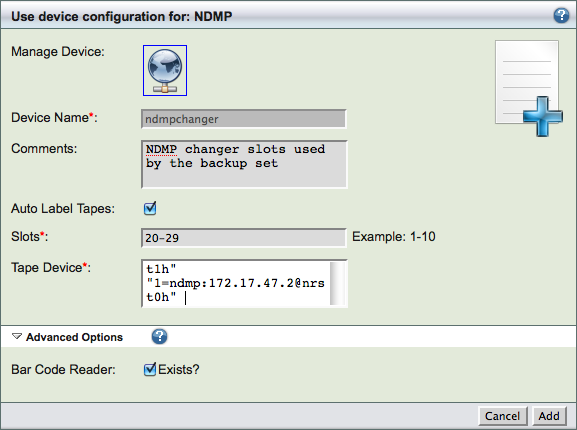
Comments can be added by the administrator about the configuration of the device in the backup set.
Auto Label tapes should be selected if tapes should be labelled automatically on first use. Please note that tapes have to be new tapes or tapes from the same backup set. Other tapes are not automatically overwritten.
Slots range that can be used by the backup set. Please ensure the slots are valid and do not overlap with other backup sets. They should not include export/import slots (which could begin in slot 1).
Tape Device is the name of tape device for each drive in the changer that can be used by the backup set. Each tape drive configuration has the format "<drive number>=ndmp:<filer IP address>@device name". For example: "0=ndmp:172.17.47.2@nrst1h" "1=ndmp:172.17.47.2@nrst0h" "2=ndmp:1
72.17.47.2@nrst2h" "3=ndmp:172.17.47.2@nrst3h" shows 4 drive tape changer accessible for appliance with IP address 172.17.47.2 with device names nrst0h, nrst1h, nrst2h and nrst3h
The device name can be obtained using Netapp filer command sysconfig -t. Use no rewind device file name.
Click Add to save the Backup Where NDMP Changer configuration. ZMC should create a configuration definition as shown in the example below in the /etc/amanda/<backup set name>/<NDMP changer name>.conf file on the Amanda server.
define changer ndmp-changer {
tpchanger "chg-ndmp:172.17.47.2@mc0"
changerfile "/etc/amanda/<backup-set-name>/disk-2-ndmp_changer.changer.conf"
property "use-slots" "19-20" # skip slots 17-18, cleaning tapes
property "tape-device" "0=ndmp:172.17.47.2@nrst1h" "1=ndmp:172.17.47.2@nrst0h" "2=ndmp:1
72.17.47.2@nrst2h" "3=ndmp:172.17.47.2@nrst3h"
property "ndmp-username" "root"
property "ndmp-password" "netapp1"
property "ndmp-auth" "text"
property "driveorder" "lru"
}
Scheduling backups of NDMP appliance
You can schedule backups using Zmanda Management Console Backup When page or run immediate backups for the backup set from the Backup Activate page.
The status of the backup are shown in the Monitor page. Backup reports will be available under the Report tab in the Zmanda Management Console.
Performing NDMP Restores using ZMC
Use Zmanda Management Console Restore What page to select the backup images to be restored. The following figure shows restoration of NDMP appliance/filer with IP address 192.168.29.155 and directory /__VOLUME__/zmanda_fs1 (partially hidden). You can select backup you want to restore from using the Backup Date field. The Host Name field is always 127.0.0.1 for NDMP application.
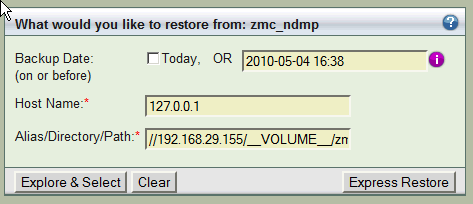
Only Express Restore is supported for NDMP at this time.
In the Restore Where page, you can select where you want the data to be restored to. You can select a different appliance/filer or different directory as restoration target. In the following figure, the Destination Directory is the filer with IP address 192.168.29.155 and directory is /vol/restorevol
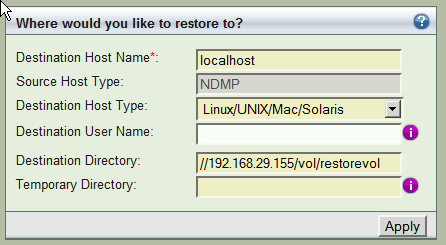
Data from a NDMP vendor can be restored only to the same vendor appliance. Temporary Directory and Destination User Name values are not used.
NDMP authentication for NDMP appliance 192.168.29.155 should be present in the NDMP authentication configuration file /etc/amanda/ndmp_filer_shares. This file should be readable only by amandabackup user. For example:
"192.168.29.155" "/vol/restorevol/" "root" "root_password" md5
or you can also have one entry for all volumes in a filer
"192.168.29.155" "*" "root" "root_password" md5
Go to Restore Restore page to start the restoration process. Amanda Enteprise does not support Direct Access Recovery (DAR).
Performing NDMP Restores using command line
This section describes how to use Amanda recovery command amrecover to perform NDMP volume/directory restoration.
- Run amrecover command on the Amanda server as root user. You will need to provide the backup set name as a parameter. The values for options -t and -s will not change.
# amrecover -C <backup set name>
- Set the host to 127.0.0.1 and the disk to DLE name that was used in the backup set configuration (use amrecover listdisk command to figure out the correct host and DLE name). The DLE name will have //<ip address or the name of filer>/<volume name>/[<directory name>]. NDMP authentication file must be configured in the /etc/amanda/<backup set name>/ndmp_filer_shares configuration file for the filer netapp1.company.com
amrecover> sethost localhost
200 Dump host set to localhost.
amrecover> setdisk //netapp1.company.com/vol/vol3
200 Disk set to //netapp1.company.com/vol/vol3
- You can list the files in the backup using ls command. Add all the files or specific files to be restored and run extract command to restore the files.
amrecover> ls 2010-03-03-17-22-35 MyData
2010-03-03-17-22-35 MyMusic
...
amrecover> add *
Added file /MyData
Added file /MyMusic
amrecover> extract
- The amrecover command asks you to load the necessary tapes to the tape changer. Confirm that the tapes are loaded. The files will be restored to the original location. Please note that existing files in the original location will be deleted.
- To restore to an alternate location on the filer or another filer (filer authentication information must be in /etc/amanda/<backup set name>/ndmp_filer_shares configuration file), you can use set property directory.
amrecover> setproperty directory //netapp1.company.com/vol/vol2/restored/
Improving Backup performance
This section provides guidelines on how to improve backup performance for NDMP backups from Netapp appliances. These guidelines are applicable for Oracle/Sun as well BlueArc appliances also (please refer to appliance manual for configuration).
- Netapp filers supports upto 16 backup and restore operations at a time. We can split volumes to be backed up into multiple backup sets and do them in parallel. This will work well for 3-way NDMP configurations because Amanda server is not a bottleneck.
- Activity on the Netapp filer during backup run will impact backups. NDMP jobs have the lowest priority compared to all other tasks on the Netapp filer.
- Check whether DAR is disabled on the filer. This change will have significant improvement in backup performance.
Run the following command on the Netapp filer.
options ndmpd.offset_map.enable off
- Check for faulty disks in the aggregate used for the volume being backed up. This can impact the backup performance.
